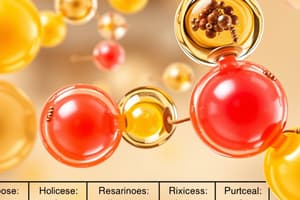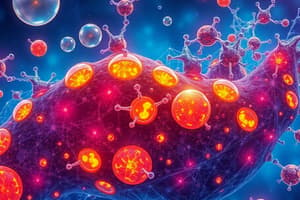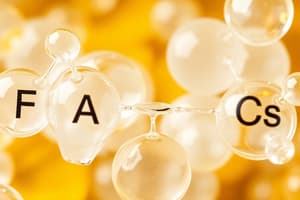Podcast
Questions and Answers
What is the primary structural feature of fats?
What is the primary structural feature of fats?
- They are composed solely of phospholipids.
- They consist of triglycerides. (correct)
- They contain only saturated fatty acids.
- They are soluble in water.
Which type of lipid is NOT classified as a complex lipid?
Which type of lipid is NOT classified as a complex lipid?
- Phospholipids
- Glycolipids
- Steroids (correct)
- Thromboxanes
What characteristic defines unsaturated fats?
What characteristic defines unsaturated fats?
- They consist solely of trans isomers.
- They are solid at room temperature.
- They contain multiple double bonds. (correct)
- They have no double bonds.
What effect do trans lipids have on cholesterol levels?
What effect do trans lipids have on cholesterol levels?
Which fatty acid is considered essential and must be obtained through diet?
Which fatty acid is considered essential and must be obtained through diet?
How is the chain length and number of double bonds in an unsaturated fatty acid typically represented?
How is the chain length and number of double bonds in an unsaturated fatty acid typically represented?
What is the primary reason for the density difference between saturated and unsaturated fats at room temperature?
What is the primary reason for the density difference between saturated and unsaturated fats at room temperature?
Which statement about omega fats is true?
Which statement about omega fats is true?
What distinguishes D-monosaccharides from L-monosaccharides?
What distinguishes D-monosaccharides from L-monosaccharides?
In cyclic sugar structures, how can you identify an alpha-sugar?
In cyclic sugar structures, how can you identify an alpha-sugar?
Which of the following statements about refined sugars is true?
Which of the following statements about refined sugars is true?
What is the correct definition of the ω-carbon in a fatty acid chain?
What is the correct definition of the ω-carbon in a fatty acid chain?
What role does alpha-amylase play in carbohydrate digestion?
What role does alpha-amylase play in carbohydrate digestion?
How far apart are the double bonds in polyunsaturated fatty acids?
How far apart are the double bonds in polyunsaturated fatty acids?
Which carbohydrate is most likely to require lactase for digestion?
Which carbohydrate is most likely to require lactase for digestion?
What is the primary function of carbohydrates in the human body?
What is the primary function of carbohydrates in the human body?
What is the primary function of bile produced by the liver?
What is the primary function of bile produced by the liver?
Where does the majority of fat digestion occur in the body?
Where does the majority of fat digestion occur in the body?
What happens to polysaccharides during digestion?
What happens to polysaccharides during digestion?
What role do chylomicrons play in fat digestion?
What role do chylomicrons play in fat digestion?
Which of the following best describes beta-sugars?
Which of the following best describes beta-sugars?
What is the general formula for carbohydrates?
What is the general formula for carbohydrates?
Which of the following statements about simple saccharides is correct?
Which of the following statements about simple saccharides is correct?
What are micelles responsible for in the digestion process?
What are micelles responsible for in the digestion process?
What distinguishes complex lipids from simple lipids?
What distinguishes complex lipids from simple lipids?
Which of the following accurately describes saturated fats?
Which of the following accurately describes saturated fats?
What is the primary role of essential fatty acids in the body?
What is the primary role of essential fatty acids in the body?
How is the omega designation of fatty acids particularly useful?
How is the omega designation of fatty acids particularly useful?
Which of the following is true regarding trans lipids?
Which of the following is true regarding trans lipids?
What characteristic is unique to polyunsaturated fats?
What characteristic is unique to polyunsaturated fats?
Which group of lipids contains prostaglandins, thromboxanes, and leukotrienes?
Which group of lipids contains prostaglandins, thromboxanes, and leukotrienes?
Which fatty acid designation is NOT commonly used to describe unsaturated fatty acids?
Which fatty acid designation is NOT commonly used to describe unsaturated fatty acids?
What is the function of bile produced by the liver in fat digestion?
What is the function of bile produced by the liver in fat digestion?
What distinguishes cis unsaturated fatty acids from trans unsaturated fatty acids?
What distinguishes cis unsaturated fatty acids from trans unsaturated fatty acids?
Where does the majority of fat digestion take place in the human body?
Where does the majority of fat digestion take place in the human body?
Which statement about the structure of carbohydrates is accurate?
Which statement about the structure of carbohydrates is accurate?
What roles do chylomicrons play in lipid digestion?
What roles do chylomicrons play in lipid digestion?
Which enzyme is primarily responsible for the hydrolysis of lipids into fatty acids and glycerol?
Which enzyme is primarily responsible for the hydrolysis of lipids into fatty acids and glycerol?
What is the main reason for the transportation of glycerides in the digestive process?
What is the main reason for the transportation of glycerides in the digestive process?
What does the position of double bonds in fatty acids indicate?
What does the position of double bonds in fatty acids indicate?
Which of the following accurately describes the difference between D-monosaccharides and L-monosaccharides?
Which of the following accurately describes the difference between D-monosaccharides and L-monosaccharides?
How can you determine if a cyclic sugar is an alpha-sugar?
How can you determine if a cyclic sugar is an alpha-sugar?
What is a significant function of carbohydrates in the body?
What is a significant function of carbohydrates in the body?
Which statement is true regarding natural sugars compared to refined sugars?
Which statement is true regarding natural sugars compared to refined sugars?
Which enzyme is responsible for breaking down disaccharides during carbohydrate digestion?
Which enzyme is responsible for breaking down disaccharides during carbohydrate digestion?
Which feature distinguishes beta-sugars in cyclic structures?
Which feature distinguishes beta-sugars in cyclic structures?
What is a primary method by which complex carbohydrates are digested?
What is a primary method by which complex carbohydrates are digested?
Which of the following carbohydrates is considered a polysaccharide?
Which of the following carbohydrates is considered a polysaccharide?
Flashcards are hidden until you start studying
Study Notes
Fats
- Fats are triglycerides, which are triesters of glycerol and long-chain carboxylic acids (fatty acids).
- Fats are insoluble in water.
- Lipids can be classified into four groups: simple, complex, steroids, and prostaglandin, thromboxane, leukotrienes.
- Complex lipids include phospholipids and glycolipids.
- Glycolipids are lipids that include carbohydrates.
- Saturated fats are denser at room temperature due to trans isomers.
- Unsaturated fats contain one or more double bonds (polyunsaturated).
- Trans lipids are essentially saturated fats that raise LDL cholesterol levels and lower HDL cholesterol levels.
- Essential fatty acids are fatty acids that the body cannot produce and must be obtained through nutrients, examples of essential fatty acids include omega-3 fatty acids, ALA, and alpha-linoleic.
- Omega fats are defined by the position of the last double bond relative to the methyl end of the fatty acid chain.
- Unsaturated fatty acids are described using a formula "(chain length: number of double bonds: locations of the double bonds)".
- The carbons of fatty acids are numbered starting with the carboxyl carbon.
- Polyunsaturated fatty acids have double bonds that are always three carbons apart with a single methylene group in between.
- Cis unsaturated fats have hydrogens on the same side of the double bond, whereas trans unsaturated fats have hydrogens on different sides of the double bond.
Functions of Lipids
- Lipids store energy.
- They are membrane components.
- They act as chemical messengers.
- They insulate and protect organs.
- Cholesterol is a precursor to vitamin D, hormones, and the sheath of body cells.
Digestion of Fats
- Lipase, produced in the pancreas, hydrolyses lipids into fatty acids and glycerol.
- The liver produces bile (stored in the gallbladder), which helps digest and emulsify fats.
- Fats are broken down from the outside because enzymes are water-soluble. This involves the use of bile salts to break large fat droplets into smaller particles (chylomicrons).
- Digestive juices are delivered to the small intestine through ducts.
- Fat digestion largely takes place in the small intestine, where nutrients are absorbed.
- Chylomicrons (tiny particles of fats and cholesterol) are formed.
- The lymphatic system (small vessels called lacteals at the center of each villus in the intestine) absorbs fat and fat-soluble nutrients from the gut.
- Micelles transport monoglycerides through the body.
- Digested fats are stored in adipocytes (adipose tissue).
Carbohydrates
- Carbohydrates are composed of carbon and water, with a general formula of C
n(H2O)n. They can also contain nitrogen and phosphorus. - Carbohydrates are very polar molecules and are soluble in water (including starches and glycogen).
- Simple saccharides include aldoses and ketoses.
- Different structures/projections exist for sugars such as glucose, including linear, Haworth projection, and 3D drawing (chair conformation).
- Carbohydrates can be classified into mono-, di-, and polysaccharides.
- Monosaccharides are the simplest sugars.
- Disaccharides are composed of two monosaccharides.
- Polysaccharides/fibers are complex carbohydrates composed of many monosaccharides.
- D-monosaccharides have the OH group on the right (on the bottom chiral center).
- L-monosaccharides have the OH group on the left (on the bottom chiral center).
- In cyclic structures, alpha sugars have the OH group below the ring, while beta sugars have the OH group above the ring.
- To determine if a sugar is alpha or beta, locate the oxygen and the anomeric carbon (carbon on the right next to the oxygen). If the OH group is up, it is beta; if it is down, it is alpha.
- Refined sugars are produced in a laboratory and do not contain fibers. They do not provide a feeling of fullness, lack nutrients and antioxidants, and quickly raise blood glucose levels.
- Natural sugars contain fibers, which slow digestion and absorption of glucose, making you feel full. They also contain nutrients like vitamin B and minerals along with antioxidants. Polysaccharides are the most abundant carbohydrates in nature.
Functions of Carbohydrates
- Carbohydrates are stored in the liver as glycogen.
- They provide energy in the form of ATP.
- They are essential components of DNA/RNA (sugar backbone).
- Sugars are needed to form glycolipids.
Digestion of Carbohydrates
- Poly-, oligo-, and disaccharides must be digested into monosaccharides to pass through the bloodstream.
- Glycosidic bonds are broken down through hydrolysis by amylases (alpha-amylase and beta-amylase).
- Alpha-amylase breaks down polysaccharides randomly.
- Beta-amylase breaks down polysaccharides in a specific order, cutting one by one from the nonreducing end.
- Amylase acts in the mouth and saliva, while the pancreas breaks down complex carbohydrates.
- Different enzymes act on specific carbohydrates, such as lactase for lactose and maltase for maltose.
Fats
- Fats are also known as triglycerides, which are triesters of glycerol and long-chain carboxylic acids (fatty acids).
- Fats are insoluble in water.
- Four groups of lipids: simple, complex, steroids, and prostaglandins, thromboxanes, and leukotrienes.
- Complex lipids are further divided into phospholipids and glycolipids.
- Glycolipids are lipids that contain carbohydrates.
- Saturated fats are denser at room temperature due to the trans isomers.
- Unsaturated fats contain one or multiple (polyunsaturated) double bonds.
- Trans lipids are like saturated fats and raise LDL cholesterol levels while lowering HDL cholesterol levels.
- Essential fatty acids are fatty acids that our body cannot produce and must be obtained through our diet. Examples of essential fatty acids are omega-3 fatty acids, ALA, and alpha-linoleic acid.
- The ω designation is useful because in the body fatty acids can only be elongated by reacting with the carboxyl group.
- The structures of unsaturated fatty acids can be described by a formula (chain length: number of double bonds: locations of the double bonds).
- The carbons of fatty acids are numbered, starting with the carboxyl carbon. Alternatively, they are designated by Greek letters.
- The double bonds of polyunsaturated fatty acids are always three carbons apart, with a single methylene (-CH₂-) group in between.
- The double bond location can be taken in relation to the carboxyl group (a Δ9 double bond, for example, is between carbons 9 and 10.)
- The cis and trans unsaturated fatty acids are determined by where the double bond is. With cis, the H atoms are on the same side of the double bond. In the trans formation they are on opposite sides of the double bond.
Functions of Lipids
- Energy storage
- Membrane components
- Chemical messengers
- Isolators and protectors for some organs
- Cholesterol: vitamin D, hormones, and cell membrane sheath
Digestion of Fats
- Lipase is produced in the pancreas and hydrolyzes lipids into fatty acids and glycerol.
- The liver produces bile, which is stored in the gallbladder and aids in the digestion and emulsification of fats.
- Bile salts break down large fat droplets into smaller particles - known as chylomicrons.
- The majority of fat digestion takes place in the small intestine.
- Chylomicrons are tiny particles of fats and cholesterol.
- The lymphatic system - the small vesicles (lacteals) absorb fats and fat-soluble nutrients from the gut.
- Micelles transport the monoglycerides through the body.
- The digested fats are stored in adipocytes/adipose tissue.
Carbohydrates (Sugars)
- Carbohydrates contain carbon and water with a general formula of Cn(H2O)n, but can also contain nitrogen and phosphorus.
- Carbohydrates are very polar molecules and are soluble in water, except for starches and glycogen.
- Simple saccharides include aldoses and ketoses.
- Glucose has different structures: linear, Haworth projection, and 3D drawing (chair conformation).
- Carbohydrates are categorized as mono-, di-, and polysaccharides.
- Monosaccharides are simple sugars.
- Disaccharides are made up of two monosaccharide units.
- Polysaccharides/fibers are complex carbohydrates containing many monosaccharide units.
Alpha/beta- and L/D sugars
- D-monosaccharide: OH-group to the right (on bottom chiral center).
- L-monosaccharide: OH-group to the left (on bottom chiral center).
- In cyclic structures, alpha-sugars have the OH group below the ring.
- Beta-sugars have the OH group above the ring.
- To determine if a sugar is alpha or beta, locate the oxygen and then locate the anomeric carbon. If the OH-group is located above the ring, it is a beta-sugar. If the OH-group is located below the ring, it is an alpha-sugar.
- Refined sugars are produced in a lab, do not contain fibers, and do not make you feel full.
- Natural sugars contain fibers, make you feel full, contain nutrients like vitamin B and minerals, and contain antioxidants. Polysaccharides are the most abundant carbohydrates in nature.
Function of Carbohydrates
- Carbohydrates are stored in the liver as glycogen.
- They provide energy in the form of ATP.
- They are essential components of DNA and RNA (sugar backbone).
- They are needed to form glycolipids.
Digestion of Carbohydrates
- Poly-, oligo-, and disaccharides must be digested into monosaccharides to be absorbed into the bloodstream.
- Glycosidic bonds are broken down by hydrolysis.
- Amylases (alpha-amylase and beta-amylase) break down complex carbohydrates.
- Alpha-amylase attacks polysaccharides at random.
- Beta-amylase attacks in an order, cutting one by one from the non-reducing end.
- Amylase works in the mouth and saliva and the pancreas breaks down complex carbohydrates.
- There are different enzymes for specific carbohydrates; for example, lactase for lactose and maltase for maltose.
Studying That Suits You
Use AI to generate personalized quizzes and flashcards to suit your learning preferences.




